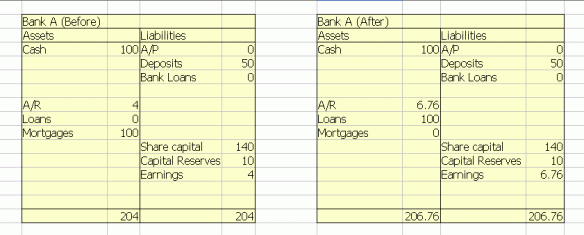In a previous post on mortgage securitization, I argued that mortgage securitization – or any other debt securitization for that matter – was nothing more than a fraudulent scheme in which money is made through fees (and comissions) but that the scheme is sure to blow up at some point, but thanks to securitization not in the faces of the ones who reaped the benefits.
Here is some more evidence that supports that argument.
Let’s start – again, because it is one of the great sources – with Barry Ritholtz’s Big Picture, who hosts a post from ABS Investor Advocate. You’ll find quite a few other good posts there.
In his post ASF and NERA Rearrange the Deck Chairs, David J. Grais, a lawyer with 30 years experience in trials of complex financial and technical disputes, makes the following point:
There is only one question worth asking about securitization: why did securitization become the seedbed of the broadest and costliest epidemic of fraud in history? Until we face that question squarely and answer it honestly, securitization will remain in its coma. Unfortunately, the Obama Administration missed a chance to address that question in its plan to regulate the securitization market. (See the post immediately below.) ASF’s sponsorship of the NERA report is more insidious. By a combination of forbidding mathematics and emollient prose (“Recent experience appears to demonstrate readily that securitization is not inherently ‘good’ or ‘bad.’”), ASF tries to whisk us past that looming question and past the one measure that will best restore confidence in securitization: effective redress for investors against those that turned securitization from a useful financial tool into an orgy of misconduct.
The ASF report referenced in his post makes a few other interesting points, not at all positive for securitization (or the ASF). In fact, the report argues that securitization was a major contributor to the financial crisis (p. 10):
Our empirical analysis shows that increases in secondary market purchases have a positive and significant impact on the amount of mortgages credit per capita, with the non-agency sector displaying a stronger impact in recent years. For example, the model suggests that a 10% increase in the secondary market purchase rate would increase mortgage loans per capita by 6.43% for a given Treasury rate of 4.5%. Higher incomes, lower unemployment rates, older borrowers, higher shares of borrowers from underserved areas, and strong price growth all correspond to higher loan amounts per capita. The results suggest that secondary market activities help increase credit availablitity to a greater extent in lower interest rate environments.
Or in other words, in environments where a loan issuer can borrow money cheaply, loans are doled out to people who normally could not get one or not one of that amount – presumably because they can’t afford it – and the rate of securitization increases (p. 10):
In addition, we document the increase in both the share of loans originated in underserved areas and the share of underserved loans sold to the secondary market. Both the dollar volume of originations in underserve dareas, as well as the share have increased since 1990 from $47 billion (16% of total originations) to as high as $609 billion in 2004 (26% of all originations).
Thus, no cheap funds and no securitization, no bubble. Please note that ‘underserved areas’ means low-income, high-minority census areas. On p. 12: Continue reading

